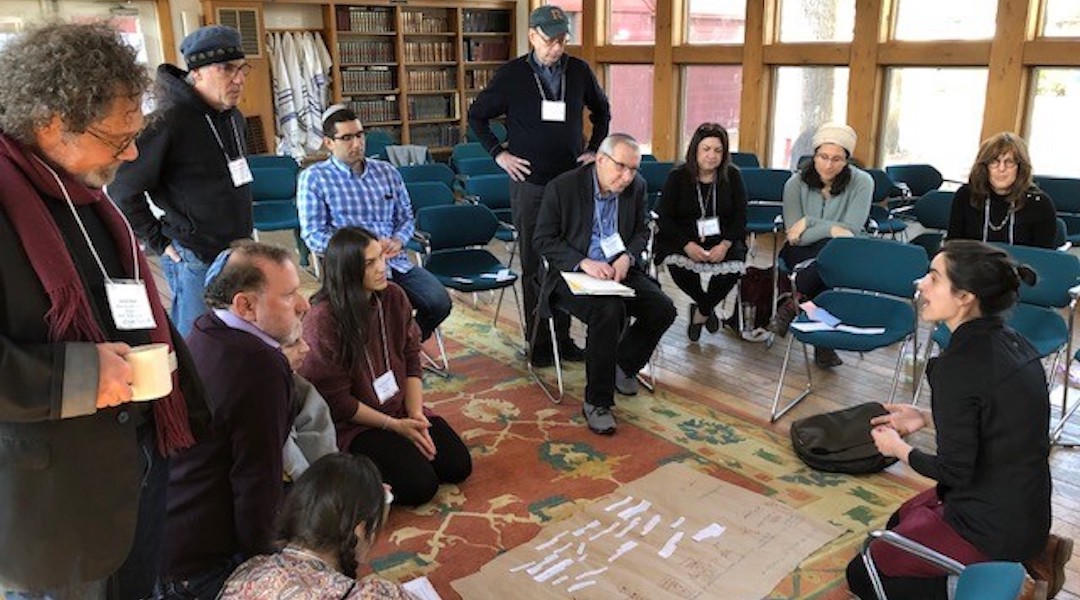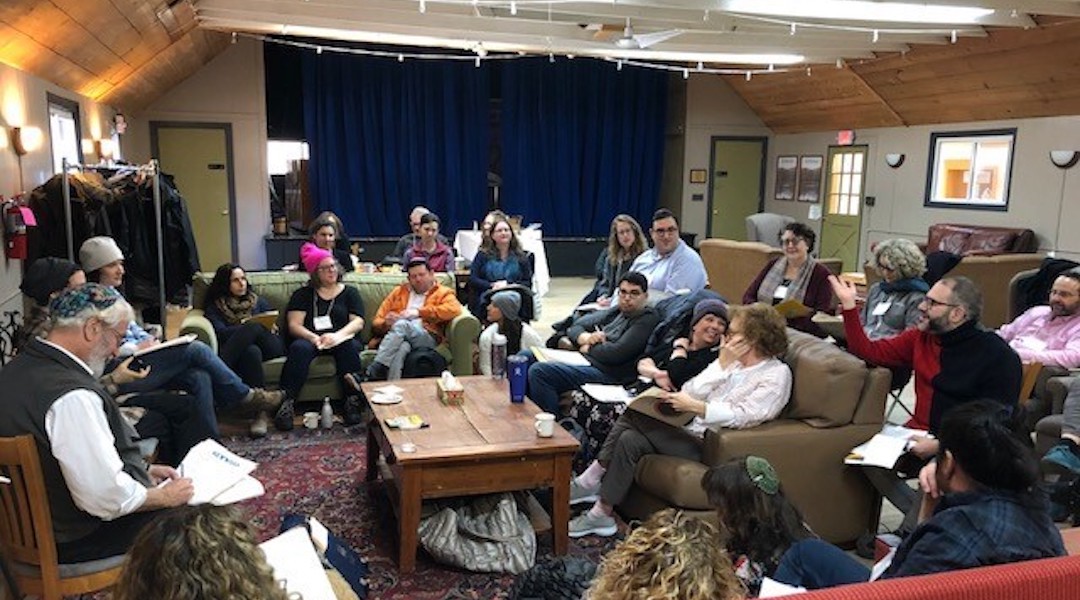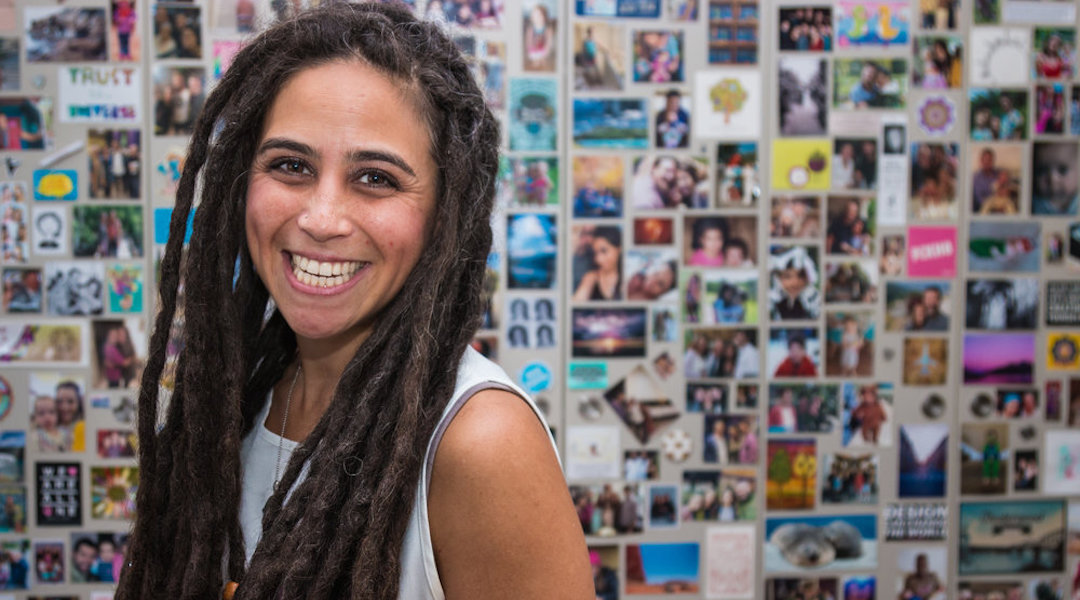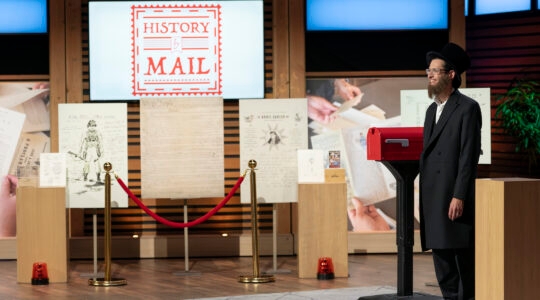(New York Jewish Week via JTA) — Keshira haLev Fife is well known in the Jewish community of her native Pittsburgh, where she conducts Shabbat services and Hebrew school classes. But she’s not your average prayer leader or educator.
As a self-described “proud Jewish woman of color,” she said she “sprinkles sparkles, disrupts expectations and offers blessings in the service of the Divine.”
She is a kohenet (Hebrew priestess), part of a small but growing international movement of mostly queer women, including self-defined witches, who emphasize the feminine aspects of “earth-based transformative Jewish ritual.”
Kohenet Keshira, as she is known, is the founder and leader of an independent, post-denominational community, Kesher Pittsburgh. Many of its devotees are previously unaffiliated multifaith or multiracial individuals, couples or families drawn to its message of openness and acceptance.
Much of the organized Jewish community in Pittsburgh does not know quite what to make of Kohenet Keshira, her spiritual vocabulary or her work, which she says includes serving as “a community weaver … davenatrix [prayer leader], life spiral ceremony officiant, ritual creatrix, liturgist and songstress.”
The mainstream synagogues in town view Kesher Pittsburgh as direct competition, though one communal leader said after attending a Shabbat service, “I hated it — but I’m happy it’s here for people who are looking for what it offers.”
Kohenet Keshira describes the prayer group as “heart-led, at the intersection of spirituality and social justice.” She said her approach focuses on welcoming people who may feel “marginalized or unwelcome” in more traditional settings.
Kohenet Keshira believes that she and others espousing broader paths to Jewish wisdom — “not just through the front door” — are no longer on the fringe. She recalled a prominent Jewish organizational professional telling her that her approach to creating community “seems to be what’s next.”
“It’s not next,” she replied. “It’s happening now.”
She has a point.
‘Communities of meaning’
Communal leaders may be surprised to learn that Kesher Pittsburgh is one of more than 400 groups across the country comprising what Rabbi Sid Schwarz calls “an emerging Jewish innovative ecosystem” that may signal the wave of the future.
An activist rabbi and communal entrepreneur based in Washington, D.C., Schwarz heads Kenissa, an organization that cultivates and tracks grassroots Jewish start-ups — independent innovators creating diverse, niche communities with an emphasis on self-expression. He said much of the Jewish establishment is either unaware of or dismissive of these groups, viewing them as too marginal to make a difference.

Mati Esther Engel, bottom right, a performance artist, ritualist and spiritual care practitioner, speaks to participants at a gathering of Kenissa, a network of Jewish “communities of meaning,” held in March 2020 in Falls Village, Conn. (Courtesy of Kenissa)
Schwarz disagrees.
While leaders of the organized Jewish community are deeply worried about the future of liberal Judaism in America — interfaith marriages, viewed by the mainstream as a sign of weakening ties to religion, continue to rise, and among the fastest growing segments of American Jews is “nones,” those who identify with no religion — Schwarz is decidedly optimistic. He believes that the new spirit of grassroots activism may well lead to a Jewish renaissance.
“These groups can be the bridge to the Jewish future,” he said.
Schwarz founded Kenissa (Hebrew for entryway), a network of “communities of meaning,” in 2015. The groups tend to offer paths to Jewish life through such portals as social justice, arts and culture, the environment, spiritual community or the search for wisdom.
Kenissa’s three main goals, according to its literature, are to “raise awareness of the impact Jewish innovation might have on American Jewish life; track the scope and reach of these new organizations; and support “more collaboration, support and partnership” between Jewish establishment organizations and “the Jewish innovative ecosystem.”
To that end, Kenissa hosted its fifth national conference in early 2020 at the Isabella Freedman Jewish Retreat Center in the Berkshires. Most of the 65 participants were categorized as “innovators” — members of the Kenissa network from around the country. They included spiritual leaders, environmental activists, cultural and artistic entrepreneurs, and those who connect to Judaism through a multiracial and justice lens.
Schwarz also invited 10 “community partners” — representatives of Jewish federations whose work involves outreach to young Jews on issues of identity, education and engagement.
In addition, there were eight “national partners/stakeholders,” including a director of strategic planning for the Jewish Agency for Israel; a director of Next Gen Engagement at the Jewish Federations of North America; representatives from Kenissa’s partners, UpStart and Hazon; and an officer of the Detroit-based William Davidson Foundation, the primary funder of Kenissa based on the foundation’s mission to support both leadership and innovation.
(I was invited to report on the conference, held March 1-3, just before the COVID pandemic closed down virtually all public and communal activities across the country.)
‘Not just a few crazy-fringe Jews’
The community and national partners were told in advance that their primary role was to observe and reflect on the discussions.
Schwarz told me that he wanted to “bring these federation folks in and let them see” that the innovators were men and women of passion and commitment and “not just a few crazy-fringe Jews.”
In his opening remarks to the assembled — a kind of inspirational pep talk — Schwarz acknowledged that “many of you operate on the margins” of the Jewish community and “sometimes feel marginalized.” But he pointed out that “change always happens from the margins” and that “you are all spiritual entrepreneurs,” risk-taking visionaries who can transform American Jewish life.
Perhaps the most striking example of margins-to-center success is Moishe House. The 15-year-old nonprofit offers subsidies for young Jewish adults to live together in a house or apartment in exchange for hosting Jewish programs for their friends and community. Its network now spans more than 27 countries.
Similarly, OneTable, a group founded in 2014 that encourages young adults to host Friday night Shabbat dinners, now has more than $4 million in assets to support its work.
Such programs are often launched by one or two people able to turn a compelling concept into a viable organization. Kenissa is eager to support such efforts. A study of its members, primarily millennials, found them to be welcoming, nonjudgmental, pluralistic, accessible, unconventional, playful and spiritual.
Those adjectives seemed appropriate for those I met, many of whom emphasized that in their work they seek to “meet people where they are,” often putting personal connections above Jewish ritual.
For one spiritual leader, that included officiating at a wedding of a Jews for Jesus couple and conducting a funeral on Shabbat — too accommodating for some conference participants.
The conference offered the Kenissa members, who tend to work in isolation from each other and mainstream communities, a chance to meet, network and share their experiences. It also provided a safe setting for innovators and potential funders to meet and learn about each other’s goals.
Such a meeting place seemed a win-win for all.
The establishment Jewish groups — Schwarz refers to them as “the legacy community” — tend to be well-funded, but keenly aware that they are losing the next generation. They are actively seeking to engage young people through creative projects promoting Jewish identity and education, giving more attention of late to the inclusion of Jews of color and the LGBT community.
The emerging communities care deeply about their missions and have had success engaging disenfranchised “seekers” by addressing their social or personal values in a Jewish context. But these groups are underresourced, lacking the infrastructure and administrative skills to build sustainable models.
The establishment and the innovators make a perfect match — at least on paper — each providing just what the other wants most.
But in real life, the legacy community and the entrepreneurs tend to be wary of each other. First, there’s a generational gap. And by nature, the establishment groups are risk-averse and often view the innovators as too “out there,” while many of the innovators fear “selling out” and being co-opted by their elders.
“We want to go in our own direction,” one Kenissa member told me the first evening. “We’re not interested in joining their Young Leadership programs.”
Over the course of 48 hours, though, both sides softened as the participants learned more about each other. The establishment folks were deeply impressed by the level of Jewish passion and commitment among the innovators, who in turn discovered community representatives who sincerely want to help support rather than control start-up initiatives.
Pandemic lessons
Nearly a full year later, the issues raised and confronted at the conference have taken on deeper significance in the age of COVID.
Gaps remain between the establishment and innovative groups, but the reality of life during the pandemic points to the shedding of old norms.
Preconceived notions about how best to sustain and grow Jewish life no longer hold. And there may well be more interest among establishment types in exploring the appeal of innovators.
The desire for personal connection, community and meaningful lives has only increased in the past year. The reliance on bricks and mortar, like synagogues and JCCs, is being reassessed. Geographic boundaries have disappeared, replaced by Zoom and similar technology, allowing people to take part in religious services and online classes virtually anywhere.
But Zoom has its limits in terms of building community. Offering virtual spaces is no substitute for in-person activities, said Rachel Berger, the director of Jewish Life and Learning at the Jewish Federation of Greater Philadelphia and a conference participant.
“You can keep your current participants engaged online, but it’s difficult to attract new people and build sustained relationships,” she said.
Communal professionals have learned the need for creative approaches, with an eye toward collaboration and shared services, and reevaluating the status quo.
“This year has taught us that every organization has to innovate,” Berger told me. “We have to keep our ear close to the ground to better know the audience.”
Some federation executives have expanded their sense of mission to include support for groups they see as outside the box and realize they may never reach.
Jeffrey Finkelstein, president and CEO of the Jewish Federation of Greater Pittsburgh, said his organization wants to “support people on their Jewish journeys,” including helping “young Jews find their connection to Judaism.”
That doesn’t necessarily mean only affiliating with a JCC or synagogue or giving to federation, he said.
“We can stick our heads in the sand or allow new start-ups to try to engage these young people because we are losing them,” Finkelstein said.

The Kenissa conference in March 2020 offered members, who tend to work in isolation from each other and mainstream communities, a chance to meet, network and share their experiences. (Courtesy of Kenissa)
But sensitive issues about politics, religion or equity can be flashpoints. An ongoing area of tension between progressive young Jews and legacy groups is Israel, particularly over the Palestinian issue. One observer called it “the third rail issue” between innovators and the Jewish establishment.
On its website, Kenissa includes an essay by one of its 2018 fellows, a community organizer with IfNotNow, a millennial group that often accuses the Jewish mainstream of complicity in the mistreatment of Palestinians by Israel. Becky Havivi calls the group’s founding “a refusal to let our generation’s relationship to Israel (and Palestine) be defined by a mainstream Jewish community.”
Serving as a Bridge
The Pittsburgh federation and Kohenet Keshira have a respectful relationship that includes some cooperation and some mutual wariness of closer ties. There was reticence from both sides on discussing specifics.
In Portland, Oregon, Eleyna Fugman, who grew up in an interfaith family in a rural area of Northern California, found her path to Judaism through racial justice more than two decades ago.
“My phrase is ‘you almost lost me,’” she said of her past, before she was drawn to the spirituality of the Jewish Renewal movement led by the late Rabbi Zalman Schachter-Shalomi.
In 2016, she co-founded TischPDX, which describes itself as “an emerging Jewish leadership incubator.” A member of the Kenissa network, it offers cohort members a stipend to participate in a 16-month program of monthly Shabbat sessions that include “Torah study, leadership training and relationship building,” according to its website. Currently there are 11 members.
“Alienation brings them together,” Fugman said of those in the East Portland program.
Some were raised in the Jewish community but felt they didn’t belong because of their sexual orientation or political views. Others came from interfaith families.
“We want to help estranged Jews and serve as a bridge,” Fugman told me. “We seek out young people doing interesting things and try to help them find their way in.”
One member runs a “queer Aleph Bet” program for adults on Zoom, teaching reading skills in Hebrew and Yiddish. Another woman leads a Shabbat book club on Friday nights.
Marc Blattner, CEO of the Jewish federation in Portland, a famously liberal city, said his organization is committed to “supporting Jewish opportunity” — projects and groups that have the potential “to grow and be meaningful,” including ones with “crunchy ideas.”
There have been discussions between Tisch (Hebrew for table) and the federation, each side exploring whether it can accommodate the interests of the other.
The leader of one such group welcomed the fact that the institutional world is showing more interest in innovative groups, but explained her hesitancy about accepting mainstream funds.
“We have to be sure that their values and our values are aligned because we’re responsible to those we serve,” she said.
The legacy institutions could make the same statement.
Innovation and Jewish tradition don’t mix easily, and in practical terms, free-wheeling new spiritual communities and the bureaucracy of legacy institutions are not a natural fit. But both sides recognize that American Judaism today needs a shot of dynamism.
In the end, one would hope that mutual interest will overcome skepticism, and that innovators and mainstream funders will find more ways to engage, learn from and help strengthen each other. After all, every establishment institution was once a start-up. Perhaps their leaders should revisit why their group came to be in the first place. And every innovative enterprise should think about what it must do to be sustainable five and 10 years from now.
Sid Schwarz acknowledges that building trusting relationships can be difficult and that it “requires shuttle diplomacy at times to bring these two worlds together.” Given his success in both of those worlds, he appears uniquely qualified for his role as “a network weaver,” as he sometimes describes himself.
“Mostly it’s about getting them to know each other,” he said.
Schwarz remains confident that Kenissa can be that catalyst for connection.
JTA has documented Jewish history in real-time for over a century. Keep our journalism strong by joining us in supporting independent, award-winning reporting.






